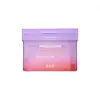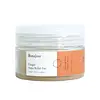What's inside
What's inside
 Key Ingredients
Key Ingredients

 Benefits
Benefits

 Concerns
Concerns

No concerns
 Ingredients Side-by-side
Ingredients Side-by-side

Water
Skin ConditioningButylene Glycol
HumectantNiacinamide
Smoothing1,2-Hexanediol
Skin ConditioningCollagen Extract
Skin ConditioningDiethoxyethyl Succinate
SolventHydroxyethyl Urea
HumectantPolyglyceryl-10 Laurate
Skin ConditioningXanthan Gum
EmulsifyingGlyceryl Caprylate
EmollientEthylhexylglycerin
Skin ConditioningAdenosine
Skin ConditioningSodium Phytate
Panthenol
Skin ConditioningCitric Acid
BufferingCapryloyl Salicylic Acid
ExfoliatingCamellia Japonica Flower Extract
EmollientTocopherol
AntioxidantLactobacillus Ferment Lysate
Skin ConditioningSoluble Collagen
HumectantAcetyl Hexapeptide-8
HumectantPalmitoyl Pentapeptide-4
Skin ConditioningAcetyl Tetrapeptide-3
Skin ProtectingPalmitoyl Tetrapeptide-7
Skin ConditioningDipeptide-2
Skin ConditioningCopper Tripeptide-1
Skin ConditioningPalmitoyl Tripeptide-1
Skin ConditioningAcetyl Tetrapeptide-5
HumectantNonapeptide-1
Skin ConditioningPentapeptide-3
Skin ConditioningDipeptide Diaminobutyroyl Benzylamide Diacetate
Skin ConditioningPalmitoyl Tripeptide-5
Skin ConditioningPalmitoyl Hexapeptide-12
Skin ConditioningTripeptide-1
Skin ConditioningHexapeptide-9
Skin ConditioningHexapeptide-11
Skin ConditioningOligopeptide-1
Skin ConditioningArginine/Lysine Polypeptide
Skin ConditioningWater, Butylene Glycol, Niacinamide, 1,2-Hexanediol, Collagen Extract, Diethoxyethyl Succinate, Hydroxyethyl Urea, Polyglyceryl-10 Laurate, Xanthan Gum, Glyceryl Caprylate, Ethylhexylglycerin, Adenosine, Sodium Phytate, Panthenol, Citric Acid, Capryloyl Salicylic Acid, Camellia Japonica Flower Extract, Tocopherol, Lactobacillus Ferment Lysate, Soluble Collagen, Acetyl Hexapeptide-8, Palmitoyl Pentapeptide-4, Acetyl Tetrapeptide-3, Palmitoyl Tetrapeptide-7, Dipeptide-2, Copper Tripeptide-1, Palmitoyl Tripeptide-1, Acetyl Tetrapeptide-5, Nonapeptide-1, Pentapeptide-3, Dipeptide Diaminobutyroyl Benzylamide Diacetate, Palmitoyl Tripeptide-5, Palmitoyl Hexapeptide-12, Tripeptide-1, Hexapeptide-9, Hexapeptide-11, Oligopeptide-1, Arginine/Lysine Polypeptide
Water
Skin ConditioningZingiber Officinale Water
MaskingButylene Glycol
Humectant1,2-Hexanediol
Skin ConditioningHydroxyethyl Urea
HumectantPropanediol
SolventGlyceryl Glucoside
HumectantHydroxyacetophenone
AntioxidantSodium Hyaluronate
HumectantPanthenol
Skin ConditioningGlycerin
HumectantAloe Barbadensis Leaf Extract
EmollientGlucose
HumectantEthylhexylglycerin
Skin ConditioningAllantoin
Skin ConditioningDipotassium Glycyrrhizate
HumectantZinc PCA
HumectantMalt Extract
Skin ProtectingGardenia Florida Fruit Extract
Skin ConditioningBioflavonoids
Skin ConditioningDextrin
AbsorbentHydrolyzed Hyaluronic Acid
HumectantBrassica Oleracea Italica Extract
AstringentHydroxypropyltrimonium Hyaluronate
Sodium Acetylated Hyaluronate
HumectantHyaluronic Acid
HumectantSodium Hyaluronate Crosspolymer
HumectantHydrolyzed Sodium Hyaluronate
Skin ConditioningCapryloyl Salicylic Acid
ExfoliatingPotassium Hyaluronate
Skin ConditioningWater, Zingiber Officinale Water, Butylene Glycol, 1,2-Hexanediol, Hydroxyethyl Urea, Propanediol, Glyceryl Glucoside, Hydroxyacetophenone, Sodium Hyaluronate, Panthenol, Glycerin, Aloe Barbadensis Leaf Extract, Glucose, Ethylhexylglycerin, Allantoin, Dipotassium Glycyrrhizate, Zinc PCA, Malt Extract, Gardenia Florida Fruit Extract, Bioflavonoids, Dextrin, Hydrolyzed Hyaluronic Acid, Brassica Oleracea Italica Extract, Hydroxypropyltrimonium Hyaluronate, Sodium Acetylated Hyaluronate, Hyaluronic Acid, Sodium Hyaluronate Crosspolymer, Hydrolyzed Sodium Hyaluronate, Capryloyl Salicylic Acid, Potassium Hyaluronate
Ingredients Explained
These ingredients are found in both products.
Ingredients higher up in an ingredient list are typically present in a larger amount.
1,2-Hexanediol is a synthetic liquid and another multi-functional powerhouse.
It is a:
- Humectant, drawing moisture into the skin
- Emollient, helping to soften skin
- Solvent, dispersing and stabilizing formulas
- Preservative booster, enhancing the antimicrobial activity of other preservatives
Butylene Glycol (or BG) is used within cosmetic products for a few different reasons:
Overall, Butylene Glycol is a safe and well-rounded ingredient that works well with other ingredients.
Though this ingredient works well with most skin types, some people with sensitive skin may experience a reaction such as allergic rashes, closed comedones, or itchiness.
Learn more about Butylene GlycolCapryloyl Salicylic Acid comes from salicylic acid, the famous acne-fighting BHA.
It usually goes by a more common name of LHA, or lipohydroxy acid.
Like salicylic acid, this ingredient is a chemical exfoliant that can help break down the oil in your pores and reduce inflammation.
Though studies for LHA do show it to be less effective than salicylic acid. To be fair, salicylic acid is the reigning monarch of acne treatments.
However, a study from 2009 found LHA to be comparable to BPO, making it a good alternative for people with sensitive skin. Another study of 14 patients found a significant decrease in comedones after using LHA.
Another pro of LHA? It is less irritating than salicylic acid due to its large molecule size.
Large molecules cannot penetrate skin as well, so they are gentler on the skin. LHA is much less penetrative than salicylic acid.
An in-vitro study (not done on a living organism) found only 6% of LHA penetrated past the statum corneum compared to 58% of salicylic acid. An in-vivo (done on a living organism) analysis revealed ~17% of LHA was still present in the top layer of skin after 4 days, versus ~9% of salicylic acid.
Interestingly, a study from 2008 found LHA comparable to another famous acid, glycolic acid.
This study found about 10% of LHA is as effective as 20-50% of glycolic acid in treating hyperpigmentation and fine-lines.
Hydroxy acids have been found to stimulate skin protein, lipids, and thermal thickening. This may have anti-aging benefits.
Learn more about Capryloyl Salicylic AcidEthylhexylglycerin (we can't pronounce this either) is commonly used as a preservative and skin softener. It is derived from glyceryl.
You might see Ethylhexylglycerin often paired with other preservatives such as phenoxyethanol. Ethylhexylglycerin has been found to increase the effectiveness of these other preservatives.
Panthenol is a common ingredient that helps hydrate and soothe the skin. It is found naturally in our skin and hair.
There are two forms of panthenol: D and L.
D-panthenol is also known as dexpanthenol. Most cosmetics use dexpanthenol or a mixture of D and L-panthenol.
Panthenol is famous due to its ability to go deeper into the skin's layers. Using this ingredient has numerous pros (and no cons):
Like hyaluronic acid, panthenol is a humectant. Humectants are able to bind and hold large amounts of water to keep skin hydrated.
This ingredient works well for wound healing. It works by increasing tissue in the wound and helps close open wounds.
Once oxidized, panthenol converts to pantothenic acid. Panthothenic acid is found in all living cells.
This ingredient is also referred to as pro-vitamin B5.
Learn more about PanthenolWater. It's the most common cosmetic ingredient of all. You'll usually see it at the top of ingredient lists, meaning that it makes up the largest part of the product.
So why is it so popular? Water most often acts as a solvent - this means that it helps dissolve other ingredients into the formulation.
You'll also recognize water as that liquid we all need to stay alive. If you see this, drink a glass of water. Stay hydrated!
Learn more about Water